 |
| May 20, 2014 | Volume 10 Issue 19 |
Materials News & Products
Designfax weekly eMagazine
Archives
Partners
Manufacturing Center
Product Spotlight
Modern Applications News
Metalworking Ideas For
Today's Job Shops
Tooling and Production
Strategies for large
metalworking plants
Weird stuff: Moon dust simulant for 3D printing
 Crafted from a lunar regolith simulant, Basalt Moon Dust Filamet™ (not a typo) available from The Virtual Foundry closely mirrors the makeup of lunar regolith found in mare regions of the Moon. It enables users with standard fused filament fabrication (FFF) 3D printers to print with unparalleled realism. Try out your ideas before you go for that big space contract, or help your kid get an A on that special science project.
Crafted from a lunar regolith simulant, Basalt Moon Dust Filamet™ (not a typo) available from The Virtual Foundry closely mirrors the makeup of lunar regolith found in mare regions of the Moon. It enables users with standard fused filament fabrication (FFF) 3D printers to print with unparalleled realism. Try out your ideas before you go for that big space contract, or help your kid get an A on that special science project.
Learn more.
Make nylon 3D-printed prototypes and parts in the office
 The new SLS 300 from 3D Systems is an affordable, turnkey, closed-loop 3D-printing system designed to operate in a smaller-footprint environment. SLS 300 makes selective laser sintering available to a broader range of customers with a high-reliability, affordable solution to produce end-use parts. Users can produce tough, durable parts from a range of production-grade nylon materials. Amazing fill, finishing, and clean-up systems.
The new SLS 300 from 3D Systems is an affordable, turnkey, closed-loop 3D-printing system designed to operate in a smaller-footprint environment. SLS 300 makes selective laser sintering available to a broader range of customers with a high-reliability, affordable solution to produce end-use parts. Users can produce tough, durable parts from a range of production-grade nylon materials. Amazing fill, finishing, and clean-up systems.
Learn more.
Will it erode? 3D-printing materials comparison from Xometry
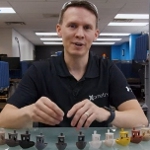 Which 3D-printed plastics are the toughest? In this "Will it ..." video, Greg Paulsen, Xometry's Director of Application Engineering, 3D printed Benchies (3D test models) using different materials (such as polycarbonate, PLA, polypropylene, ULTEM, and Nylon 11 and 12) and processes (such as FDM, SLS, MJF, SLA, LSPc, Polyjet, and DLS) and then ran several abrasion tests on them. Watch to find out which 3D-printed plastic is truly the toughest of them all!
Which 3D-printed plastics are the toughest? In this "Will it ..." video, Greg Paulsen, Xometry's Director of Application Engineering, 3D printed Benchies (3D test models) using different materials (such as polycarbonate, PLA, polypropylene, ULTEM, and Nylon 11 and 12) and processes (such as FDM, SLS, MJF, SLA, LSPc, Polyjet, and DLS) and then ran several abrasion tests on them. Watch to find out which 3D-printed plastic is truly the toughest of them all!
View Part 1.
View Part 2.
Graphene Handbook: Learn all about this wonder material
 Metalgrass LTD has published the 11th edition of its "Graphene Handbook," a comprehensive resource on graphene technology, the industry, and the market for this wonder material made of single layers of atoms of pure carbon. The book includes development history, production methods, current research, an intro to metrology and standardization, and even an investment guide. Under 100 bucks for digital edition. Hard copy available too.
Metalgrass LTD has published the 11th edition of its "Graphene Handbook," a comprehensive resource on graphene technology, the industry, and the market for this wonder material made of single layers of atoms of pure carbon. The book includes development history, production methods, current research, an intro to metrology and standardization, and even an investment guide. Under 100 bucks for digital edition. Hard copy available too.
Learn more.
Who knew? How colorants affect plastic
 In plastic injection molding, one aspect of polymer characteristics that doesn't always get the consideration it deserves is the addition of colorant. Believe it or not, there is a whole scientific body of knowledge about the ways in which adding color to plastic can affect its behavioral properties. This short article by Denny Scher of ICO Mold takes a high-level look at some of the different, and surprising, ways colorants can affect plastics.
In plastic injection molding, one aspect of polymer characteristics that doesn't always get the consideration it deserves is the addition of colorant. Believe it or not, there is a whole scientific body of knowledge about the ways in which adding color to plastic can affect its behavioral properties. This short article by Denny Scher of ICO Mold takes a high-level look at some of the different, and surprising, ways colorants can affect plastics.
Read the full article.
Retaining magnets from JW Winco: Universal and clever
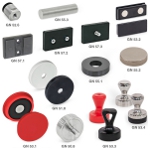 JW Winco has expanded its magnet line to support more applications with new materials, shapes, systems, and even raw magnets. Learn about their latest offerings, including retaining magnets designed for corrosive environments (GN 50.8), encapsulated magnets designed for sensitive or painted surfaces (GN 51.8), handle magnets (GN 53.3), and powerful magnets designed to handle challenging environs (GN 52.6).
JW Winco has expanded its magnet line to support more applications with new materials, shapes, systems, and even raw magnets. Learn about their latest offerings, including retaining magnets designed for corrosive environments (GN 50.8), encapsulated magnets designed for sensitive or painted surfaces (GN 51.8), handle magnets (GN 53.3), and powerful magnets designed to handle challenging environs (GN 52.6).
Learn more.
3D print tool steel with the ease of a plastic
 The Virtual Foundry, a pioneer in advanced 3D-printing materials, is excited to announce the launch of their latest innovation: M300 Tool Steel Filamet™ (not a typo). This material answers the demand for FFF 3D-printable Tool Steel, delivering unparalleled strength and versatility. What sets this material apart is its seamless compatibility with various 3D printers, including Creality, Bambu Lab, Ultimaker, and more. The filament prints effortlessly, resembling the ease of working with PLA (plastic).
The Virtual Foundry, a pioneer in advanced 3D-printing materials, is excited to announce the launch of their latest innovation: M300 Tool Steel Filamet™ (not a typo). This material answers the demand for FFF 3D-printable Tool Steel, delivering unparalleled strength and versatility. What sets this material apart is its seamless compatibility with various 3D printers, including Creality, Bambu Lab, Ultimaker, and more. The filament prints effortlessly, resembling the ease of working with PLA (plastic).
Learn more.
Great Resources: Sheet metal design guide
 If you're looking for a basic guide to sheet metal design, this one from Xometry will serve your needs well. Follow the design requirements and tolerances in this guide to ensure parts fall closer to design intent. This is the type of information you'll sock away and then refer to again and again.
If you're looking for a basic guide to sheet metal design, this one from Xometry will serve your needs well. Follow the design requirements and tolerances in this guide to ensure parts fall closer to design intent. This is the type of information you'll sock away and then refer to again and again.
Read the full article.
Particle foam perfectly distributed thanks to simulation with Ultrasim
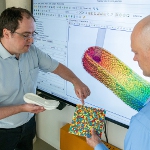 BASF's Ultrasim simulation solution now includes Infinergy, an expanded thermoplastic polyurethane (E-TPU) that is used in a wide range of applications to make components with particle foam -- from bicycle tires to the soles on shoes. Identify and solve problems related to pneumatic filling when distributing particle foams in molds, even taking gravity and mold closing into consideration. Avoid those pesky air pockets.
BASF's Ultrasim simulation solution now includes Infinergy, an expanded thermoplastic polyurethane (E-TPU) that is used in a wide range of applications to make components with particle foam -- from bicycle tires to the soles on shoes. Identify and solve problems related to pneumatic filling when distributing particle foams in molds, even taking gravity and mold closing into consideration. Avoid those pesky air pockets.
Learn more.
Premium polymer DLP printer is half the price of its predecessor
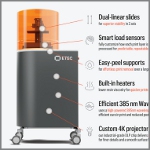 Desktop Metal has just launched the ETEC Pro XL -- a premium polymer digital light processing (DLP) printer that enters the market at less than half the price as its predecessor. DLP is regarded by many as a superior polymer 3D-printing technology for speed, surface finish, and accuracy. Ideal for automotive and machine parts, aerospace components, housings, connectors, jigs and fixtures, short-run molds, and more.
Desktop Metal has just launched the ETEC Pro XL -- a premium polymer digital light processing (DLP) printer that enters the market at less than half the price as its predecessor. DLP is regarded by many as a superior polymer 3D-printing technology for speed, surface finish, and accuracy. Ideal for automotive and machine parts, aerospace components, housings, connectors, jigs and fixtures, short-run molds, and more.
Read the full article.
CNC machining case study: One-of-a-kind computer chassis
 Learn how Josh Sniffen, the YouTuber behind the popular PC-building channel "Not From Concentrate," trusted Xometry to provide a wide range of manufacturing options, personalized Design for Manufacturing (DFM) feedback, and order management support for his latest creation: the HEXO ATX computer chassis. All in all, Sniffen procured parts using Xometry's CNC machining service, selective laser sintering 3D-printing service, and sheet metal cutting and fabrication services. A neat insider look at the process.
Learn how Josh Sniffen, the YouTuber behind the popular PC-building channel "Not From Concentrate," trusted Xometry to provide a wide range of manufacturing options, personalized Design for Manufacturing (DFM) feedback, and order management support for his latest creation: the HEXO ATX computer chassis. All in all, Sniffen procured parts using Xometry's CNC machining service, selective laser sintering 3D-printing service, and sheet metal cutting and fabrication services. A neat insider look at the process.
Read this Xometry case study.
Which parts should be 3D printed? AI combs through CAD files to find out
 One of the biggest challenges in transitioning to additive manufacturing (AM) is the ability to identify which parts are best suited for the process quickly and easily. Learn how Danfoss, Stanley Engineered Fastening, and even the U.S. military have utilized advanced additive manufacturing software to automate the process, reducing material waste and energy costs, improving part reliability, decreasing lead times, as well as now having the ability to identify part consolidation opportunities through intelligent AM decision-making.
One of the biggest challenges in transitioning to additive manufacturing (AM) is the ability to identify which parts are best suited for the process quickly and easily. Learn how Danfoss, Stanley Engineered Fastening, and even the U.S. military have utilized advanced additive manufacturing software to automate the process, reducing material waste and energy costs, improving part reliability, decreasing lead times, as well as now having the ability to identify part consolidation opportunities through intelligent AM decision-making.
Read the full article.
9 key design tips for injection molding
 Keep costs down and quality up all while optimizing your injection molded designs with these helpful tips from Xometry. Learn how to build better injection molded parts and products -- using draft angles, ribs and gussets, radii, fillets, and more -- and set expectations for the injection molding process. Good info here.
Keep costs down and quality up all while optimizing your injection molded designs with these helpful tips from Xometry. Learn how to build better injection molded parts and products -- using draft angles, ribs and gussets, radii, fillets, and more -- and set expectations for the injection molding process. Good info here.
View the video.
Metal additive manufacturing: Rocket turbopump design
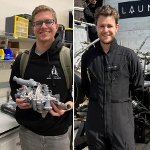 Mixing undergraduate curiosity and real-world engagement, two students from Colorado University Boulder Aerospace Engineering Sciences program, Zachary Lesan and Patrick Watson, started an independent effort on turbopump design and manufacture that is a lesson in determination and industry collaboration. With lots of supplies and advice from industry heavy hitters including Velo3D, CFturbo, SpaceX, and many more, their project has reinforced significant points being made about next-generation rocketry.
Mixing undergraduate curiosity and real-world engagement, two students from Colorado University Boulder Aerospace Engineering Sciences program, Zachary Lesan and Patrick Watson, started an independent effort on turbopump design and manufacture that is a lesson in determination and industry collaboration. With lots of supplies and advice from industry heavy hitters including Velo3D, CFturbo, SpaceX, and many more, their project has reinforced significant points being made about next-generation rocketry.
Read the full article.
Transparent ceramics for extreme optics
 Sapphire is an inherently transparent ceramic material that is resistant to extremes of temperature and environment. Sapphire can be processed to unique and precise shape/form by diamond grinding and polishing to allow full transparency. INSACO is a global leader in this capability -- and working with ultra-hard materials in general.
Sapphire is an inherently transparent ceramic material that is resistant to extremes of temperature and environment. Sapphire can be processed to unique and precise shape/form by diamond grinding and polishing to allow full transparency. INSACO is a global leader in this capability -- and working with ultra-hard materials in general.
Learn more.
New class of industrial polymers discovered by IBM Research
Scientists from IBM Research have successfully discovered a new class of polymer materials that can potentially transform manufacturing and fabrication in the fields of transportation, aerospace, and microelectronics.
Through the unique approach of combining high-performance computing with synthetic polymer chemistry, these new materials are the first to demonstrate resistance to cracking, strength higher than bone, and the ability to reform to their original shape (self-heal) -- all while being completely recyclable back to their starting material. Also, these materials can be transformed into new polymer structures to further bolster their strength by 50 percent -- making them ultra strong and lightweight.
This research was published May 15 in the peer-reviewed journal Science, with collaborators including UC Berkeley, Eindhoven University of Technology, and King Abdulaziz City for Science and Technology (KACST), Saudi Arabia.
Polymers, a long chain of molecules that are connected through chemical bonds, are an indispensable part of everyday life. They are a core material in common items ranging from clothing and drink bottles (polyesters), paints (polyacrylics), plastic milk bottles (polyethylene), and secure food packaging (polyolefins, polystyrene) to major parts of cars and planes (epoxies, polyamides, and polyimides). They are also essential components in virtually every emerging advanced technology dating back to the industrial revolution: the steam engine, the space ship, the computer, the mobile phone.
However, today's polymer materials are limited in some ways. In transportation and aerospace, structural components or composites are exposed to many environmental factors (de-icing of planes, exposure to fuels, cleaning products, etc.) and exhibit poor environmental stress crack resistance (i.e., catastrophic failure upon exposure to a solvent). Also, these polymers are difficult to recycle because they cannot be remolded or reworked once cured or thermally decomposed by heating to high temperatures. As a result, these end up in the landfill together with toxins such as plasticizers, fillers, and color additives that are not biodegradable.
IBM's discovery of a new family of materials with a range of tunable and desirable properties provides a new opportunity for exploratory research and applications development to academia, materials manufacturers, and end users of high-performance materials. Two new related classes of materials have been discovered that possess a very distinctive range of properties that include high stiffness, solvent resistance, the ability to heal themselves once a crack is introduced, and to be used as a resin for filled composite materials to further bolster their strength.
Also, the ability to selectively recycle a structural component would have significant impact in the semiconductor industry, advanced manufacturing, or advanced composites for transportation, as one would be able to rework high-value but defective manufactured parts or chips instead of throwing them away. This could bolster fabrication yields, save money, and significantly decrease microelectronic waste.
Materials science innovation usually considered 'mature'
The field of material science is often thought of as a mature field, with the most recent new class of polymer materials being discovered and introduced to the commercial market decades ago. Also, most current polymer research involves studying polymers that are "old" polymers and combining known polymers together or simply adjusting chemical functional groups on known polymers to access desired properties, as opposed to making completely new polymers.
IBM scientists used a novel "computational chemistry" hybrid approach to accelerate the materials discovery process that couples lab experimentation with the use of high-performance computing to model new polymer-forming reactions. The unconventional method is a departure from traditional techniques and led to the identification of several previously undiscovered classes of polymers in what was believed to be an established area of materials science researched extensively since the 1950s.
Ideally, scientists could insert a list of requirements into a computer to design a material that meets those exact conditions. Unfortunately, the reality now is that materials are still primarily discovered only by experimenting in the lab based on the scientist's knowledge, experience, and educated guesses. IBM Research's computational chemistry efforts can take out a lot of this guesswork and accelerate a whole new range of potential applications, from developing disease-specific drugs or cheap, light, tough, and completely recyclable panels on a car.
How it works
These polymers, formed from the same inexpensive starting material through a condensation reaction, were created in an operationally simple procedure and are incredibly tunable.
At high temperatures (250 deg C), the polymer becomes incredibly strong due to a rearrangement of covalent bonds and loss of the solvent that is trapped in the polymer (now stronger than bone and fiberboard), but as a consequence is more brittle (similar to how glass shatters).
Remarkably, this polymer remains intact when it is exposed to basic water (high pH), but selectively decomposes when exposed to very acidic water (very low pH). This means that under the right conditions, this polymer can be reverted back to its starting materials, which enables it to be reused in other polymers. The material can also be manufactured to have even higher strength if carbon nanotubes or other reinforcing fillers are mixed into the polymer and are heated to high temperatures. This process enables polymers to have properties similar to metals, which is why these "composite blends" are used for manufacturing in airplanes and cars. An advantage to using polymers in this case over metals is that they are lighter weight, which in the transportation industry translates to savings in fuel costs.
At low temperatures (just over room temperature), another type of polymer can be formed into elastic gels that are still stronger than most polymers, but maintain their flexibility because of a solvent that is trapped within its compositional network, stretching like a rubber band.
Probably the most unexpected and remarkable characteristic of these gels is that if they are severed and the pieces are placed back in proximity so they physically touch, the chemical bonds are re-formed between the pieces, making it a single unit again within seconds. This type of polymer is called a "self-healing" polymer and is made possible in this case due to hydrogen-bonding interactions in the hemiaminal polymer network. One could envision using these types of materials as adhesives or mixing in with other polymers to induce self-healing properties in the polymer mixture. Furthermore, these polymers are reversible constructs, which means that they can be recycled in neutral water and that they might find use in applications that require reversible assemblies, such as drug cargo delivery.
Source: IBM
Published May 2014
Rate this article
View our terms of use and privacy policy
